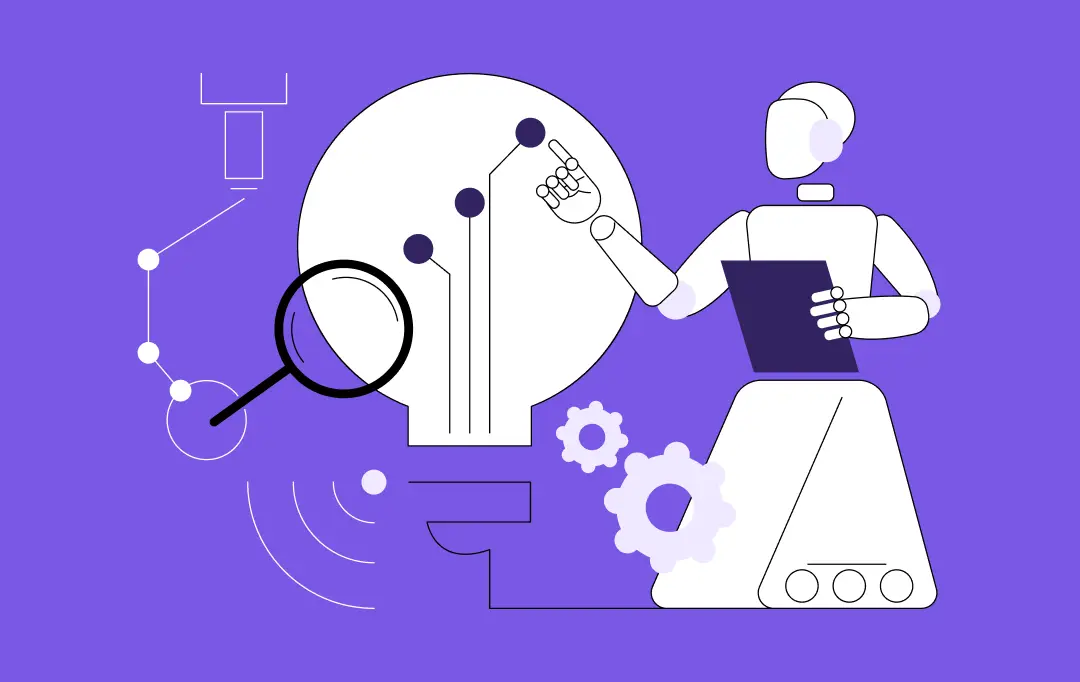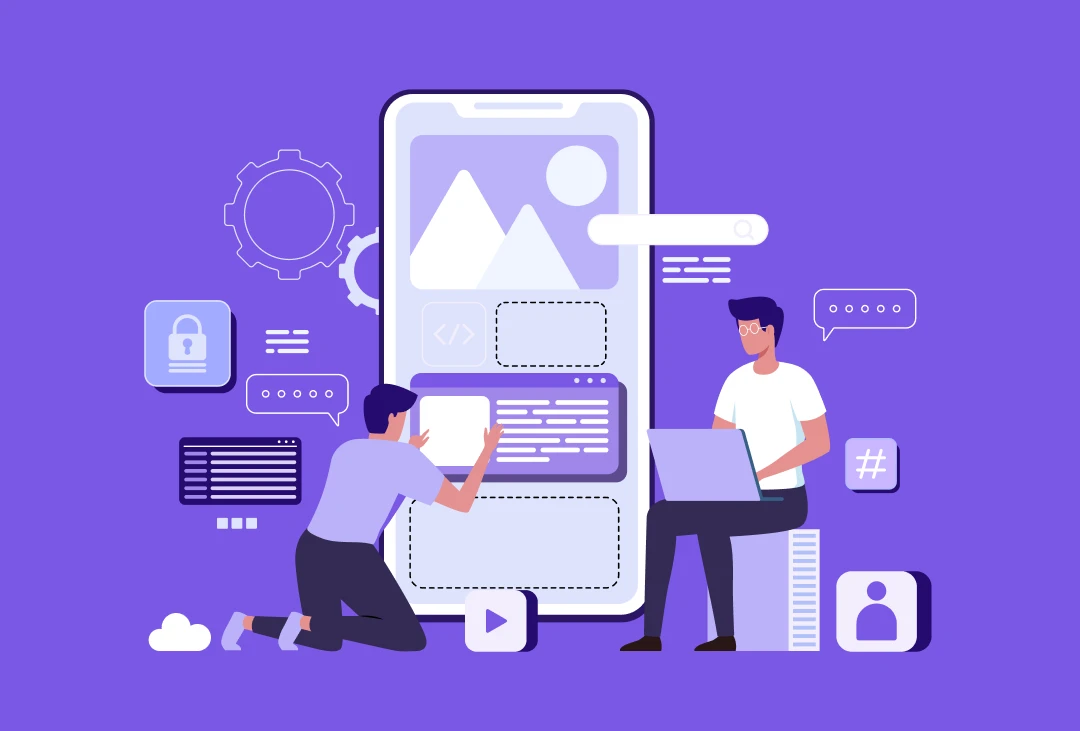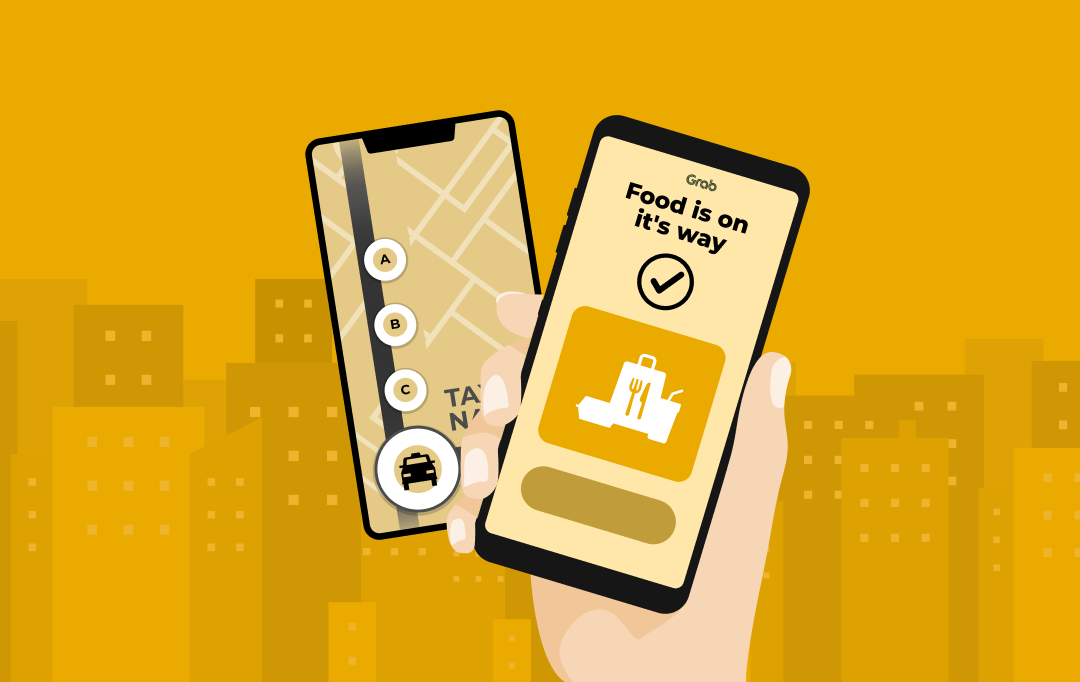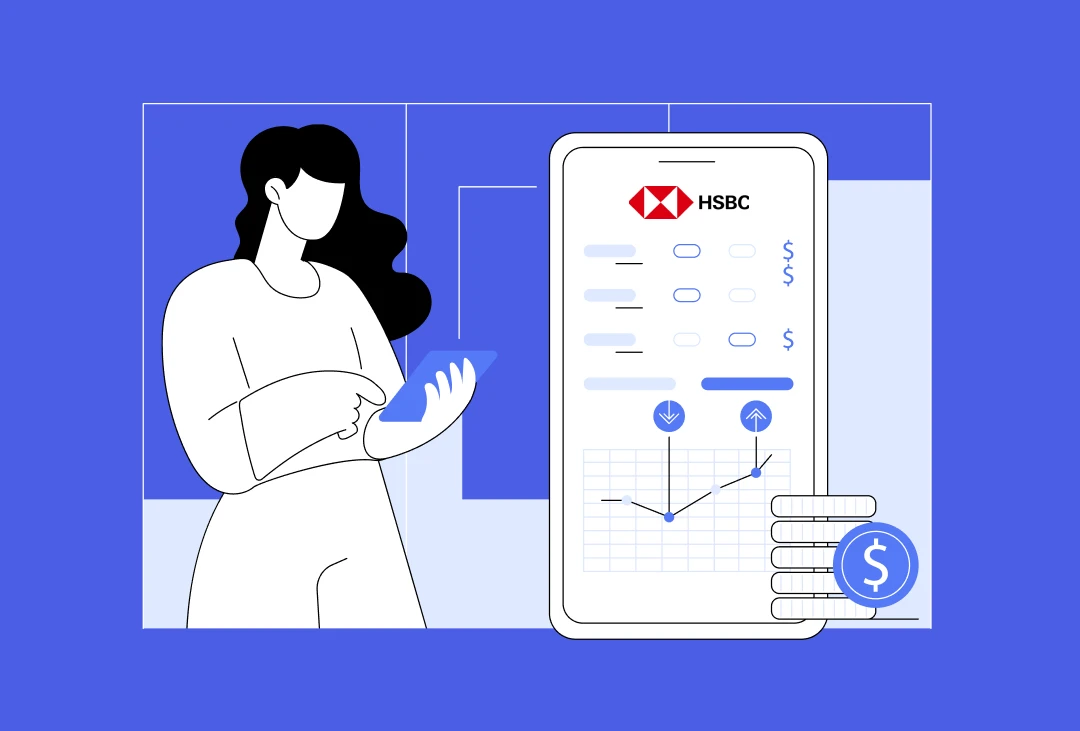Today’s consumer is busier than ever, yet they are getting increasingly conscious about healthy eating, portion control, and convenience. This has created a fertile market for meal planners and meal kit delivery apps like HelloFresh. These platforms simplify healthy eating and offer pre-portioned ingredients, curated recipes, and flexible meal plans all delivered to the user’s doorstep.
If you’re planning to build an app like HelloFresh, one of the first questions that comes up is: How much does it cost to build a meal planner app like HelloFresh?
On average, the cost of developing a meal planner app like HelloFresh ranges between $40,000 and $250,000+, depending on various factors such as features, tech stack, complexity, development team location, and other relevant considerations.
When considering the cost of HelloFresh app development, it’s essential to think beyond the initial budget and plan for long-term growth and scalability.
But the real answer is far more nuanced.
Creating an app like HelloFresh isn’t just about putting recipes online. It involves multiple layers of technology, ranging from complex e-commerce integrations and recipe databases to real-time inventory management, delivery tracking, dietary preference algorithms, and secure payment gateways.
These platforms also need robust logistics support to ensure ingredients remain fresh and orders are fulfilled on time, making them far more sophisticated than typical food delivery apps.
So, if you’re planning to develop an app like HelloFresh or create a meal prep delivery app like HelloFresh, this is the right time, but it’s important to understand what goes into building such an app from the ground up. In this blog, we’ll talk about the HelloFresh app development cost breakdown, including the key features, monetization model, development roadmap, and more.
According to Statista, the U.S. online food delivery market reached a total value of $353.3 billion in 2024. Grocery delivery led with $257 billion, while meal delivery services contributed around $96 billion. The numbers reflect the growing consumer preference for digital meal planning and doorstep convenience. Meanwhile, Gen Z consumers are leading adoption trends.
Let’s explore the comprehensive overview of a meal kit delivery app, including its development cost, key features, and process in 2025.
Overview of a Meal Planner App: HelloFresh
HelloFresh is one of America’s most popular meal kit delivery apps, designed to make home cooking easier, faster, and more personalized. Users start by setting their meal preferences, such as vegetarian, quick meals, or calorie-smart, then choose how many meals they want per week and for how many people.
How does HelloFresh work?
Once the plan is set, the app takes care of the rest.
- It sends weekly boxes with pre-portioned ingredients and step-by-step recipe cards that are easy to follow, even for beginners, to the user’s doorstep.
- The app also allows users to skip a week, swap meals, update their delivery schedule, or manage payments with just a few taps.
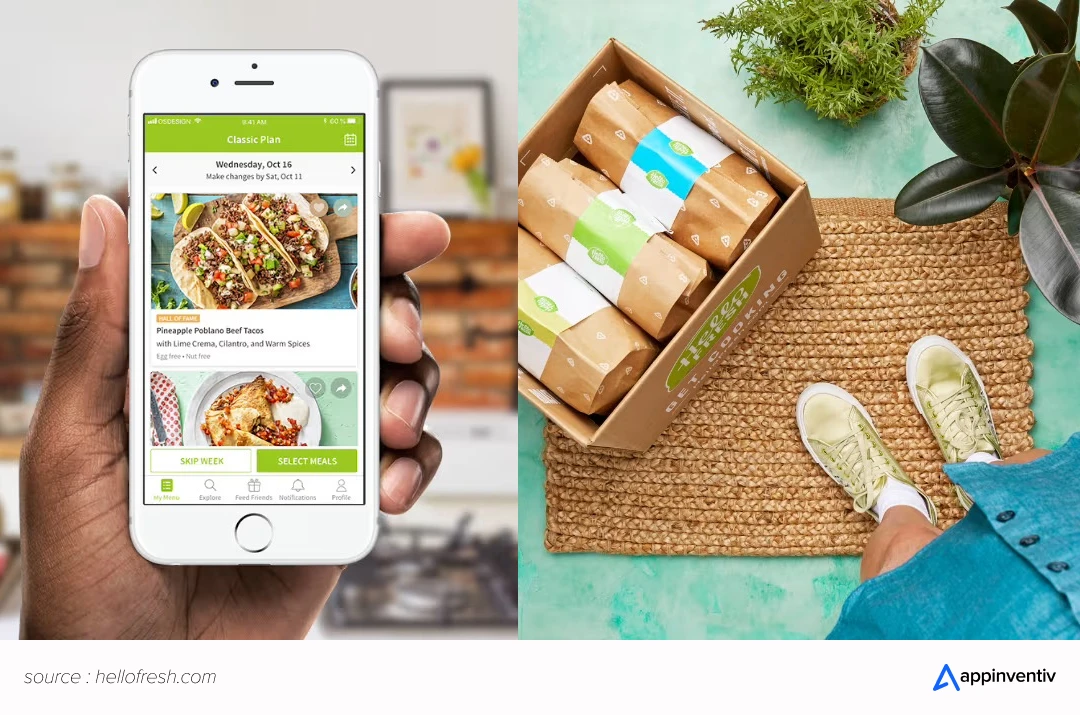
- For users, it brings the convenience of food delivery with the health and satisfaction of cooking at home.
- For businesses, it’s a model that combines e-commerce, logistics, and personalization, giving customers more control over their shopping experience while generating steady revenue through subscriptions.
To create a meal prep delivery app like HelloFresh, it’s essential to analyze both their business and technical features and aspects that make them stand apart in the market.
Key Features of the HelloFresh App
The HelloFresh app combines personalized meal planning with smooth subscription logistics. Its interface is built to simplify weekly cooking while keeping users in control of their preferences, schedules, and ingredients.
Below is a breakdown of the business and Technical features of the meal planner app like HelloFresh, and how the app is structured across its key user-facing features.
Business Features of HelloFresh Meal Kit App
a. Users can easily sign up, manage, pause, or cancel meal kit subscriptions.
b. Flexible plans (weekly, bi-weekly, etc.) and serving sizes (2, 4 people, etc).
- Meal Selection & Customization
a. Browse weekly menus with a variety of recipes.
b. Select meals based on preferences (dietary restrictions, cuisine types, calories).
c. Option to swap or skip meals.
- Personalized Recommendations: Tailored meal suggestions based on user preferences and order history through an AI-powered recommendation system.
- Order Tracking & Delivery Scheduling
a. Real-time tracking of meal kit delivery.
b. Flexible delivery date and time slot selection.
- Promotions & Discounts: Integration of promo codes, referral discounts, and first-time user offers.
- Payment & Billing
a. Secure payment gateway supporting multiple payment methods.
b. Transparent billing history and receipts.
- User Account & Profile Management: Manage personal info, dietary preferences, and delivery addresses.
- Customer Support: In-app chat or help center for FAQs, order issues, or feedback.
- Push Notifications & Reminders: Alerts for new menus, delivery updates, subscription renewals, and promotions.
Bonus Read: How to Build a Push Notification Strategy For Higher Conversions
Technical Features of HelloFresh Meal Kit App
- Cross-Platform Compatibility
a. Native iOS and Android apps for smooth performance.
b. Responsive design for tablets and smartphones.
a. Robust backend to handle user data, orders, inventory, and logistics.
b. Integration with CRM, payment gateways, and delivery management systems.
- Personalization Engine: Algorithms to recommend meals based on preferences, past orders, and trends.
- Real-Time Order Tracking: GPS and delivery partner integration for live tracking.
- Secure Authentication & Authorization
a. Social login options (Google, Facebook, Apple).
b. OAuth2, Multi-factor authentication, and encrypted data storage.
- Push Notification System: Integration with Firebase Cloud Messaging (FCM) or Apple Push Notification Service (APNs).
- Payment Integration: PCI-DSS compliant payment processing via Stripe, PayPal, or similar services.
- Content Management System (CMS): For managing recipes, menus, images, and nutritional info without app updates.
Bonus Read: A Guide to Content Management System Development
- Analytics & Reporting: User behavior tracking, order analytics, and performance metrics.
- Offline Mode & Caching: Limited offline access for browsing saved recipes or meal plans.
- API Integration: Interfaces for third-party services like delivery logistics, marketing platforms, and customer service tools.
Cost to Build a Meal Planner App Like HelloFresh
Typically, meal kit delivery app development cost ranges from $40,000 to $250,000 or more, depending on your specific requirements and scale.
The cost to develop a meal planner app like HelloFresh depends on several factors, including core features, supported platforms, UI/UX complexity, integrations, security requirements, and ongoing maintenance. Let’s explore the detailed structure of the cost of developing a meal planner app like HelloFresh.
Cost Analysis Based on App Features and Functionalities
Basic apps cover essential meal planning and recipe management, while advanced versions include personalized nutrition recommendations and subscription services. Premium apps integrate real-time grocery delivery or smart kitchen devices, requiring complex backend and API work.
| Feature Complexity |
Description |
Cost Range |
| Basic Features |
User onboarding, creating meal plans, recipe database, shopping list, calendar sync, push notifications. Ideal for MVPs or simpler apps. |
$40,000-$85,000 |
| Advanced Features |
Personalized meal recommendations based on dietary preferences, AI-driven nutrition tips, subscription management, and in-app payments. |
$90,000-$160,000 |
| Premium Features |
Real-time grocery delivery integration, voice assistant commands, social sharing, detailed analytics, and smart kitchen device integration. |
$180,000+ |
Cost Analysis Based on UI/UX Design Complexity
A simple UI meets basic user needs but often falls short in competitive markets. Advanced UI/UX design encompasses personalized experiences, animations, and accessibility, which adds cost but significantly enhances user experience and app adoption.
| UI/UX Level |
Description |
Cost Range |
| Simple UI/UX |
Basic clean layouts, straightforward navigation, and mobile-responsive design across iOS and Android. |
$4,000-$10,000 |
| Advanced UI/UX |
Interactive meal planners, custom animations, dynamic grocery lists, multi-theme support, enhanced accessibility. |
$12,000-$30,000 |
Cost Analysis Based on Technology Stack and Platform
Choosing the right technology stack and platforms influences not only the upfront development cost but also scalability and maintenance. For businesses looking to build an app like HelloFresh, tech stack decisions can affect time-to-market and future upgrades.
| Platform Type |
Description |
Cost Range |
| Single Platform |
Web-only or single native app (iOS or Android). Backend APIs using Node.js, Python, or Java. |
$40,000-$110,000 |
| Multi-Platform |
Native iOS and Android apps, web portal, or cross-platform development with Flutter or React Native. |
$140,000+ |
Cost Analysis Based on Third-Party Integrations
Each integration adds development complexity and recurring costs, but significantly enhances app value and user convenience.
| Integration Type |
Description |
Cost Range |
| Payment Gateways |
Subscription management and in-app purchases. Example: Stripe, PayPal |
$5,000-$12,000 |
| Grocery Delivery APIs |
Real-time order placement and delivery tracking. Example: Instacart, Walmart |
$12,000-$35,000 |
| Nutrition APIs |
Calorie counting, nutritional info, and diet tracking. Example: Edamam |
$3,000-$8,000 |
| Push Notifications |
Meal reminders, promotions, and user engagement. Example: OneSignal |
$2,000-$6,000 |
Cost Analysis Based on Security and Compliance
Meal planner apps handle sensitive user data, including health and payment information, making security and compliance non-negotiable. These compliances can help your business avoid legal risks and should be considered as part of the meal kit delivery app development cost.
| Security Level |
Description |
Cost Range |
| Basic Security |
SSL encryption, GDPR/CCPA compliance, secure authentication, and data privacy standards. |
$3,000-$7,000 |
| Advanced Security |
Multi-factor authentication, PCI-DSS for payments, and secure API communication. |
$8,000-$20,000 |
Cost Analysis Based on Maintenance and Support
Post-launch maintenance is often underestimated but essential for app longevity. Annual maintenance for meal planner apps generally costs 15–20% of the original development cost. This covers bug fixes, platform updates, performance monitoring, server costs, and feature enhancements.
Bonus Read: Understanding App Maintenance Costs in 2025
Quick Formula to Estimate Meal Kit Deliver App Development Cost
If you’re in the early planning phase, this formula provides a solid foundation for estimating the cost to build a meal planner app like HelloFresh and mapping out your budget.
Total Cost = (Development Hours × Hourly Rate) + Cost of Cloud/API Infrastructure + Licensing/Compliance Fees
Example:
1,200 hours × $65/hour = $78,000 (base development cost)
(Note: Hourly rates vary depending on the development team’s location, expertise in the domain, and technology stack used.)
How Long Does it Take to Develop a Meal Planner App Like HelloFresh?
It typically takes around 6 to 10 months to develop an app like HelloFresh, depending on its scope and complexity. Ideally, you should start with an MVP featuring core meal planning and shopping list functionalities. Utilize early user feedback to inform the prioritization of advanced features and integrations.
| Phase |
What does it include? |
Duration |
| Discovery & Planning |
Market research, user persona development, feature prioritization, technology stack selection |
3-4 weeks |
| UI/UX Design |
Wireframing, prototyping, user testing, and design approval |
4-6 weeks |
| Development |
Backend & frontend development, API & third-party integrations |
12-18 weeks |
| Testing & QA |
Functional, usability, security, and performance testing |
3-5 weeks |
| Deployment |
Server setup, app store submission, backend deployment |
2-3 weeks |
| Post-launch Support |
Monitoring, updates, bug fixing, feature enhancements |
Ongoing |
Key Factors Influencing Meal Planner App Development Cost
Understanding the factors affecting meal planner app development cost is essential for accurately estimating the total budget. From UI/UX design and feature set to backend infrastructure, integrations, and security, each element can significantly impact your app’s cost structure and long-term ROI.
| Factor |
What does it do? |
Cost Impact |
| UI/UX Design Complexity |
Includes diet-specific customization, accessibility features, and user-friendly interfaces, from basic layouts to highly interactive meal plan dashboards. |
$4,000-$30,000 |
| Backend Development |
Covers core logic, including meal planning algorithms, user profile management, and subscription/payment workflows, ranging from basic CRUD operations to AI-powered personalization. |
$18,000-$75,000 |
| Third-Party Integrations |
Integration of essential services like payment gateways (Stripe), grocery APIs (Instacart), and nutrition databases (Edamam). |
$5,000-$35,000+ |
| Platform Selection |
Development across one or more platforms, native iOS/Android, or cross-platform with a web portal, based on the target audience. |
$40,000-$140,000+ |
| Advanced Technologies |
Use of AI/ML for dietary recommendations, voice assistant support (like Alexa), or integration with IoT kitchen devices. |
$18,000-$55,000+ |
| Security & Compliance |
Ensuring compliance with data protection laws and secure payments through standards like GDPR and PCI-DSS. |
$3,000-$20,000 |
Hidden Costs & Miscellaneous Expenses
Beyond core development, the cost to build a meal planner app like HelloFresh also involves several operational and post-launch expenses that are often overlooked during initial budgeting. These include:
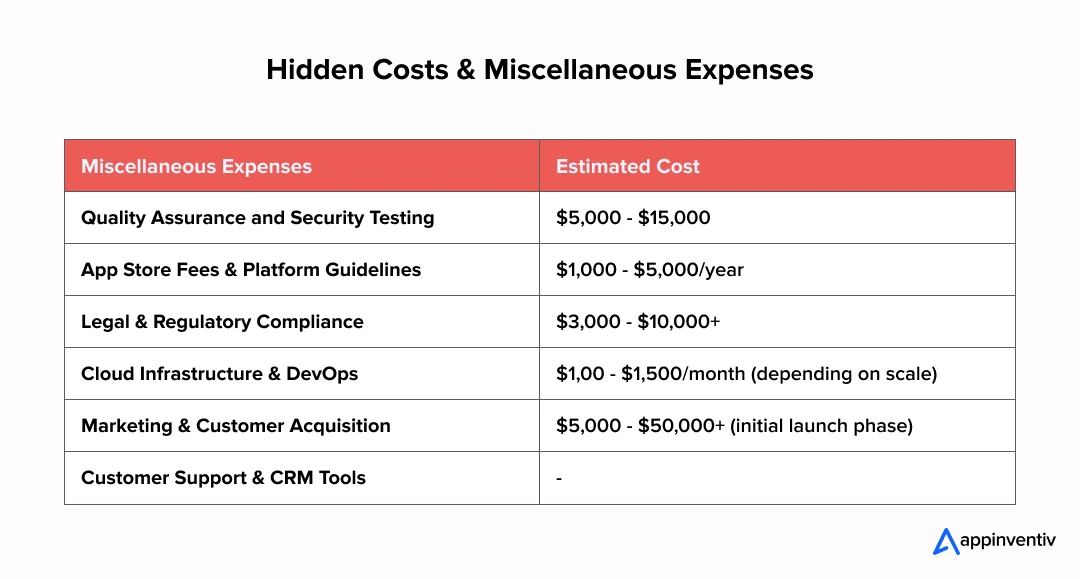
- Quality Assurance and Security Testing
Meal kit apps must perform flawlessly across devices while securely handling sensitive user data like payment details and dietary preferences. It requires rigorous QA to ensure smooth functionality, fast load times, and robust data protection, something that significantly contributes to the overall HelloFresh app development cost.
Estimated Cost: $5,000-$15,000
- App Store Fees & Platform Guidelines
Publishing your app on Google Play and Apple App Store involves more than just uploading a build. You’ll need developer accounts, which cost $25 (one-time) for Google Play and $99/year for Apple. Additionally, both platforms take a 15-30% commission on in-app purchases and subscriptions.
Estimated Cost: $1,000-$5,000/year
- Legal & Regulatory Compliance
In the U.S., apps handling personal data must comply with data privacy regulations, such as the California Consumer Privacy Act (CCPA), the General Data Protection Regulation (GDPR), and, in some cases, the Health Insurance Portability and Accountability Act (HIPAA) when health data is involved. This typically requires legal consultations, updated privacy policies, and regular audits, which are additional cost factors when developing an app like HelloFresh with user trust at its center.
Estimated Cost: $3,000-$10,000+
- Cloud Infrastructure & DevOps
Meal planner apps depend heavily on backend performance, cloud storage (for user data and recipe content), and database operations. Utilizing services like AWS, Google Cloud, or Azure entails ongoing infrastructure costs, particularly as your user base expands. For businesses trying to create an app like HelloFresh, a scalable architecture is essential.
Estimated Cost: $1,00-$1,500/month (depending on scale)
- Marketing & Customer Acquisition
Once your app is live, you’ll need to invest in performance marketing, influencer campaigns, app store optimization (ASO), and email/onboarding automation to drive installs and conversions. These expenses are often overlooked when calculating the actual cost of developing a meal planner app like HelloFresh.
Estimated Cost: $5,000-$50,000+ (initial launch phase)
- Customer Support & CRM Tools
User experience and retention in subscription-based models heavily rely on responsive customer support. This includes setting up chatbots, support agents, ticketing systems, and CRM tools like Zendesk or Intercom.
Estimated Cost: $1,000-$10,000/year
Strategies to Optimize the Cost of Your Meal Planner App
Meal planner app development costs often rise due to feature overload, poor technical decisions, or underestimating future scalability needs. But these issues are avoidable. Here are five practical strategies to reduce costs without sacrificing quality:
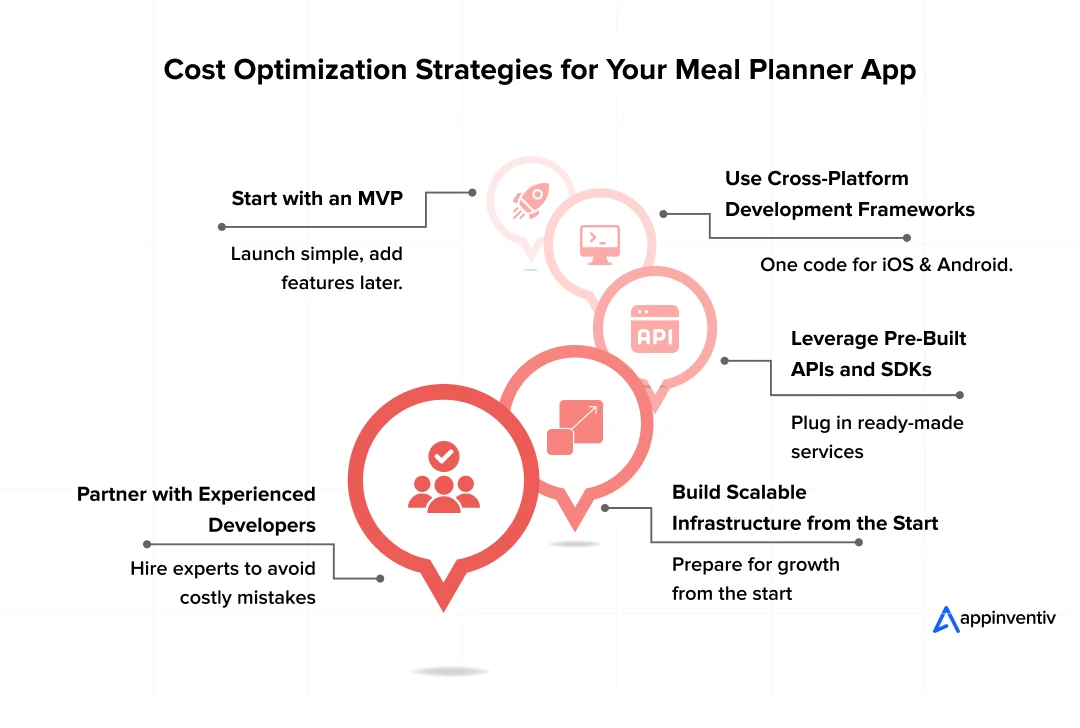
- Start with a Minimum Viable Product (MVP)
Instead of developing custom diet personalization right away, launch with standard meal templates for popular diets (e.g., keto, vegan). Once users start engaging, analyze which templates they prefer, then invest in AI-powered MVP customization. This prevents spending on features that may not be widely used.
- Use Cross-Platform Development Frameworks
Building one app that works seamlessly on both iOS and Android can cut your development and maintenance costs by nearly half, as it eliminates the need for separate codebases. Using Flutter or React Native, your team can write a single codebase that runs on multiple platforms.
- Leverage Pre-Built APIs and SDKs
Integrate ready-made third-party services for complex functionalities like nutrition data, recipe suggestions, or payment processing. Instead of building your own food database, integrate a popular nutrition API that provides detailed calorie and macro breakdowns for thousands of ingredients. This way, your app instantly provides accurate nutrition information without requiring months of data collection and validation.
- Build Scalable Infrastructure from the Start
Design your app’s backend with scalability in mind, so it can grow with your user base without requiring expensive redesigns. Utilizing cloud platforms like AWS or Google Cloud with auto-scaling capabilities enables your app to handle traffic spikes smoothly. If your app suddenly goes viral, your infrastructure adjusts automatically, preventing crashes and costly emergency fixes.
- Partner with Experienced Developers
Working with a team of mobile app developers that has hands-on experience in building health and wellness apps can significantly reduce your trial-and-error costs. Partner with an experienced partner like Appinventiv, who knows how to optimize database queries for quick recipe searches, which improves app speed. This avoids performance issues that often cause delays, which can drive up the cost of building a meal planner app like HelloFresh.
Must-Have Features in Your Meal Kit App
Creating a meal kit app like HelloFresh requires a blend of user-friendly features, robust admin tools, and advanced functionalities to stand out in the competitive food tech market. Below, we outline essential features to include, inspired by HelloFresh’s successful model, to ensure a seamless user experience and efficient business operations.
User Panel Features
- Weekly Meal Selection: Users receive a curated list of weekly recipes tailored to their meal plan. They can easily swap meals, choose portion sizes, or skip a week with a few taps.
- Dietary Preferences & Filters: The app enables users to filter recipes by their nutritional needs, such as vegetarian, pescatarian, low-calorie, or family-friendly, allowing them to match meals with their lifestyle.
- Subscription & Delivery Management: Users can manage deliveries, reschedule, pause, or cancel directly from the app. It also allows address changes and flexible delivery slots.
- In-app Cooking Mode: Each recipe includes a step-by-step cooking guide with timers and visuals. This cooking mode enables users to prepare meals without needing to switch between screens.
- Order Tracking & Notifications: Push notifications alert users when meals are out for delivery. Users can also track their orders in real-time through their account dashboard.
- Recipe Library Access: Beyond weekly orders, users can browse thousands of past HelloFresh recipes, save their favorites, and revisit them anytime.
Admin Panel Features
- Order & Inventory Sync: The backend syncs customer orders with inventory data in real time, ensuring fresh ingredients are matched to each weekly meal kit and reducing waste.
- CMS for Menu Updates: Admins can add or adjust recipes weekly, highlight seasonal dishes, and update nutritional content without developer intervention.
- User & Subscription Analytics: HelloFresh uses internal dashboards to monitor user behavior, churn rates, meal popularity, and forecast supply chain needs.
- Offer & Discount Management: Referral codes, onboarding offers, and retention discounts are all centrally managed by the backend marketing team.
- Sustainability Metrics Dashboard: A dedicated dashboard to track sustainability metrics is essential. Admins can monitor carbon footprint per order, packaging waste, and sourcing of sustainable ingredients.
- AI-Powered Demand Forecasting: Leverage AI and machine learning to predict meal kit demand based on user behavior, seasonal trends, and regional preferences, while optimizing inventory.
- Automated Workflow Triggers: Implement automated workflows for repetitive tasks, such as sending approval requests for new recipes, scheduling promotional emails, or flagging low inventory levels.
- Health & Nutrition Compliance Tools: As health-conscious diets (e.g., keto, paleo, vegan) grow in popularity, provide admins with tools to ensure recipes comply with specific dietary certifications or nutritional standards.
Advanced Functionalities
- AI-driven Personalization: The app uses past order history and preferences to pre-select meals weekly and suggest new recipes users might enjoy.
- Integration with Voice Assistants: Users can connect Alexa or Google Assistant to ask what’s on the menu or get cooking instructions hands-free.
Bonus Read: How Can Google Voice Assistant App Make Your Business Efficient?
- Multi-device Sync: Whether on mobile, tablet, or desktop, users can manage their HelloFresh account seamlessly across platforms.
- Nutritional Analysis and Health Goal Tracking: Add AI-driven nutritional analysis that scans recipes or user-uploaded meals to estimate calories, macronutrients, and micronutrients, aligning with specific health goals.
- Predictive Inventory and Waste Reduction: Implement AI algorithms to predict ingredient usage patterns based on user behavior and seasonal trends, helping users avoid overbuying and reduce food waste.
- Augmented Reality (AR) Cooking Guidance: Incorporate AR to provide immersive cooking tutorials, where users can view step-by-step instructions overlaid on their kitchen workspace via their phone or AR glasses. For example, AR could display precise chopping techniques or portion sizes in real-time.
These advanced features do affect the cost to develop a meal planner app, but they also help deliver real value to users and long-term returns for businesses.
Revenue Model of a Meal Planner Delivery App
Now that we’ve covered the meal planner app development cost breakdown, let’s take a closer look at the revenue model of a meal planner delivery app and understand how these apps typically make money:
- Subscription Plans: This is the main source of income. Customers pay a weekly or monthly fee for a set number of meals.
- One-Time Purchases: Not everyone wants a subscription. Offering the option to purchase individual meals, snacks, or extras, such as drinks and desserts, attracts casual users and increases overall sales.
- Premium Pricing for Specialty Kits: Meal kits with special diets like keto, vegan, or gourmet recipes can be priced higher. These premium options add value for customers willing to pay more and help boost average order size.
- Affiliate Partnerships: Many apps partner with brands selling kitchen gadgets, utensils, or health supplements. They earn commissions by promoting these products within the app, adding another revenue layer without extra costs.
- In-App Advertising: Sponsored recipes or brand campaigns within the app enable companies to reach targeted users, generating additional income through advertising.
Also Read: How Do Apps Make Money: Strategies to Boost Your Revenue Potential
Understanding the cost to build a meal planner app like HelloFresh becomes even more crucial when planning monetization strategies. Your revenue strategy has a direct impact on your return on investment (ROI) and long-term sustainability.
How to Develop an App Like HelloFresh: Step-by-Step Process
Creating an app like HelloFresh, a meal kit delivery service, requires careful planning and execution to create a user-friendly, scalable, and efficient platform. Below is a concise, step-by-step guide that covers the essential aspects of the development process.
Step 1: Market Research and Planning
Understand the meal kit industry and analyze competitors, such as HelloFresh. Identify your target audience, their preferences, and any pain points they may have. Define your app’s unique selling points (e.g., dietary customization, eco-friendly packaging). Create a detailed project plan with goals, timelines, and a budget.
Step 2: Define Features and Functionality
Outline the core features:
- User Profiles: Account creation, preferences, and dietary restrictions.
- Menu Selection: Weekly meal plans with filters for nutritional needs.
- Subscription Management: Flexible plans, payment integration, and cancellations.
- Order Tracking: Real-time delivery updates.
- Recipe Instructions: Step-by-step guides with images or videos.
- Push Notifications: Order confirmations, promotions, and reminders.
- Customer Support: In-app chat or ticketing system. Prioritize a seamless user experience (UX) with intuitive navigation.
Step 3: Choose the Technology Stack
Select a robust tech stack for scalability and performance:
- Frontend: React Native or Flutter for cross-platform mobile apps.
- Backend: Node.js with Express or Django for server-side logic.
- Database: PostgreSQL or MongoDB for managing user data, orders, and inventory.
- APIs: Integrate payment gateways (Stripe, PayPal), mapping services (Google Maps), and push notifications (Firebase).
- Cloud Services: AWS or Google Cloud for hosting and storage. Ensure the stack supports real-time updates and high traffic.
Step 4: Design the User Interface (UI)
Create wireframes and prototypes to visualize the app’s layout. Design a clean, modern UI with a focus on:
- Easy navigation for browsing meals and placing orders.
- Visually appealing meal images and clear recipe instructions.
- Responsive design for mobile and web compatibility. Use tools like Figma or Adobe XD for design collaboration.
Step 5: Development
Adopt an agile methodology for efficient development:
- Backend Development: Build APIs for user authentication, menu management, order processing, and inventory tracking. Use Node.js or Django for robust server-side logic.
- Frontend Development: Develop the app interface using React Native or Flutter for iOS and Android compatibility.
- Integration: Connect frontend to backend APIs and third-party services like payment gateways (Stripe, PayPal) and delivery tracking (Google Maps).
Bonus Read: How to Choose the Right CRM for Your Business
- Version Control: Use Git for collaboration and code management. Ensure modular coding for scalability and maintainability.
Step 6: Testing
Conduct thorough testing to ensure reliability:
- Unit Testing: Test individual components (e.g., API endpoints, UI elements).
- Integration Testing: Verify seamless interaction between frontend, backend, and APIs.
- User Acceptance Testing (UAT): Gather feedback from beta users to confirm usability.
- Performance Testing: Check app speed and scalability under high traffic.
- Security Testing: Ensure data encryption and secure payment processing to protect sensitive information. Fix bugs and optimize based on test results.
Step 7: Launch
Release a beta version to a small user group for feedback. Address issues and refine features. Publish the app on the Google Play Store and the Apple App Store. Promote through:
- Social media campaigns targeting food lovers.
- Collaborations with influencers or dietitians.
- SEO-optimized blogs and landing pages for organic reach. Monitor initial user feedback to ensure a smooth launch.
Step 8: Support, Maintenance, and Upgrades
Maintain and enhance the app:
- Monitor Performance: Use Google Analytics or Mixpanel to track user behavior.
- Feature Updates: Add features such as advanced filters or loyalty programs based on customer feedback.
- Bug Fixes: Address issues promptly to ensure stability.
- Scalability: Upgrade cloud infrastructure to support a growing user base.
- Security Updates: Conduct audits to maintain compliance.
Bonus Read: Understanding App Maintenance Costs in 2025
Challenges to Develop a Meal Planner App Like HelloFresh
To create a meal prep delivery app like HelloFresh, getting the tech right, listing recipes, and enabling deliveries isn’t enough. The real challenge is making it work in the real world, managing food logistics, offering smart personalization, and keeping things running smoothly at scale.
Here are the most common challenges product teams face:
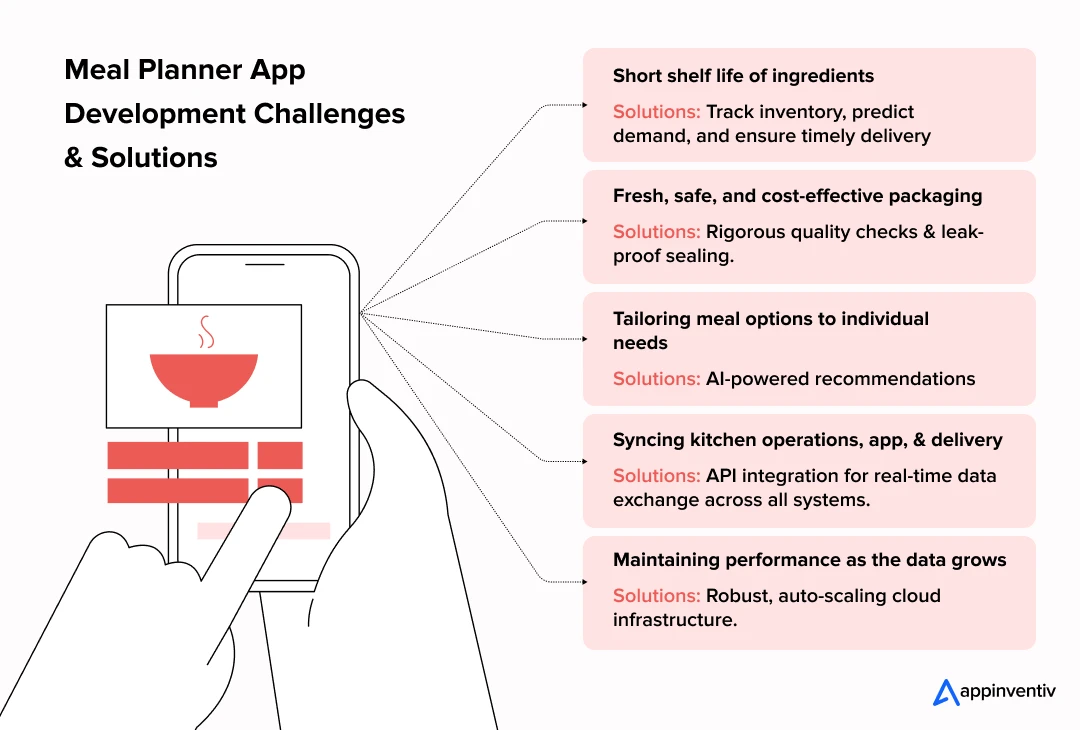
- Managing Fresh Inventory and Timely Delivery
Unlike other products, ingredients have a short shelf life; therefore, it is essential to stay vigilant in this regard.
Solution: You need a well-coordinated system to track inventory, predict demand, and ensure timely deliveries without creating excess waste or delays.
- Packaging That’s Fresh, Safe, and Eco-Friendly
Meal kits must stay fresh, leak-proof, and temperature-controlled during delivery. Balancing cost, safety, and environmental consciousness is a significant operational challenge.
Solution: Implement rigorous quality checks and leak-proof sealing techniques to ensure safety and freshness throughout transit.
- Making Personalization Work at Scale
Customers expect meal options tailored to their dietary needs, allergies, and fitness goals. Building an app that adapts to user preferences in real-time takes smart recommendation engines and a well-structured backend.
Solution: Develop AI-powered recommendation engines that analyze user dietary preferences, allergies, and fitness goals to deliver tailored meal options.
- Managing Kitchen-to-Door Logistics
From recipe prep to packaging and dispatch, the backend operations must sync perfectly with the app. It often requires integration with multiple vendors, warehouse systems, and last-mile delivery services.
Solution: Integrate the app with kitchen management, vendor, warehouse, and delivery systems via APIs for seamless real-time data exchange.
- Scaling Without Breaking the Experience
As your user base grows, so do the technical demands. Latency, load balancing, and managing a growing database of recipes, user data, and logistics info require a solid cloud infrastructure.
Solution: Build on a robust cloud infrastructure with auto-scaling capabilities to handle spikes in user traffic and data load.
Thinking of scaling from the beginning? The cost of developing a meal planner app like HelloFresh will vary depending on the level of readiness of your infrastructure for future growth. Early investments in scalability can save you from costly upgrades down the line.
Build a Meal Planner App Like HelloFresh with Appinventiv
The meal kit delivery industry is booming, and consumers are increasingly looking for convenient, personalized, and healthy meal solutions. If you’ve been dreaming of launching your meal planner app, offering curated recipes and fresh ingredients delivered to doorsteps, then you’re on the right track! And when it comes to bringing that vision to life, partnering with a seasoned expert is key.
That’s where Appinventiv comes in.
If you imagine an app that simplifies meal planning, tantalizes taste buds with diverse recipes, and streamlines the entire cooking process, much like the popular HelloFresh.
We specialize in turning imagination into reality, offering comprehensive mobile app development services designed to create an app like HelloFresh that stands out in a crowded market.
Building a successful meal kit app requires more than just coding; it demands a deep understanding of food tech, logistics, and user behavior. Here’s why Appinventiv is your ideal partner:
With years of experience in the food tech and delivery app landscape, we understand the intricate challenges of meal kit logistics, regulatory compliance, and delivering truly personalized user experiences.
We’ve worked with big giants like KFC. Their app required an extension in the UAE to achieve a better global presence. Their immediate requirement was to improve QR functionality, facilitate multiple order modes, and initiate advanced analytics. We have curated solutions to enhance the customer experience, resulting in a 28% increase in conversion rate. It began by conceptualizing, designing, and deploying the right digital solutions.
With a global team of over 1,600 experts and a portfolio boasting over 3,000 successfully delivered projects across diverse industries (including a strong showing in food and delivery apps), we have the proven capabilities to bring your meal planner app to life with excellence.
Contact us now to bring your culinary vision to life digitally.
FAQs
Q. What is the future of the Meal Kit Delivery app development?
A. Meal kit delivery apps are evolving fast. The future will bring more AI-driven personalization, smarter inventory and delivery logistics, and greener, sustainable packaging. Integration with smart home devices and voice assistants will make ordering even easier, while expanding into new markets and dietary trends will keep these apps relevant and growing.
Q. How Does Meal Prep Delivery App Work?
A. A meal prep delivery app helps users choose meals based on their tastes, dietary needs, and schedule. It then coordinates with suppliers to deliver fresh, pre-portioned ingredients right to their doorstep. Behind the scenes, the app handles everything from order management to delivery tracking and inventory control to ensure freshness and timely service.
Q. How much does it cost to make a meal planner app like HelloFresh?
A. The cost to build a meal planner app like HelloFresh typically ranges from $40,000 to $250,000. This depends on the app’s complexity, features like AI-based personalization, real-time inventory management, and integrations with third-party services for payment and delivery.
Q. What are the must-have features for a meal planner delivery app?
A. Essential features include flexible subscription plans, personalized meal recommendations, easy order management, real-time delivery tracking, and secure payment options. Advanced apps also offer AI-driven suggestions and integration with nutrition tracking tools.
Q. How long does it take to develop a meal planner app like HelloFresh?
A. On average, it takes around 6 to 10 months to develop a full-featured meal planner app. This includes design, development, testing, and deployment phases.
Q. What are the important benefits to Build a Meal Kit Delivery App like HelloFresh?
A. When you create a meal prep delivery app like HelloFresh, you’re tapping into real benefits that help your business grow, keep customers coming back, and stand out from the competition. Here’s what you can expect:
- Predictable Recurring Revenue
- Easy Market Expansion and Product Diversification
- Opportunities for Partnerships and Cross-Selling
IT Managed & Outsourcing
Didn't find what you're looking for? Let us know your needs, and we'll tailor a solution just for you.





